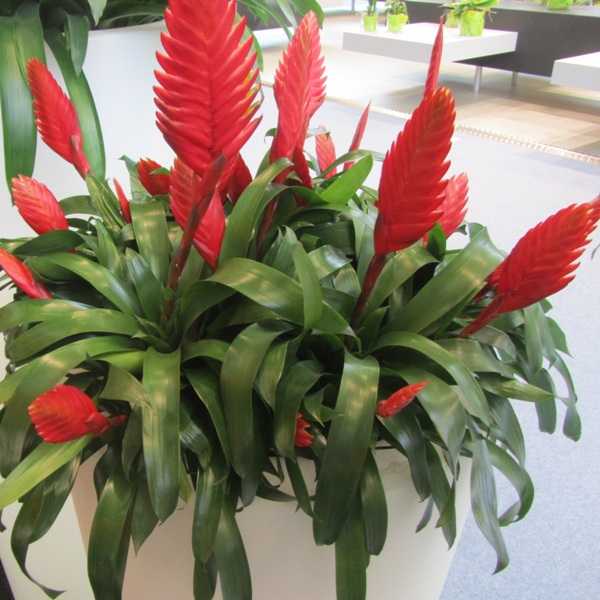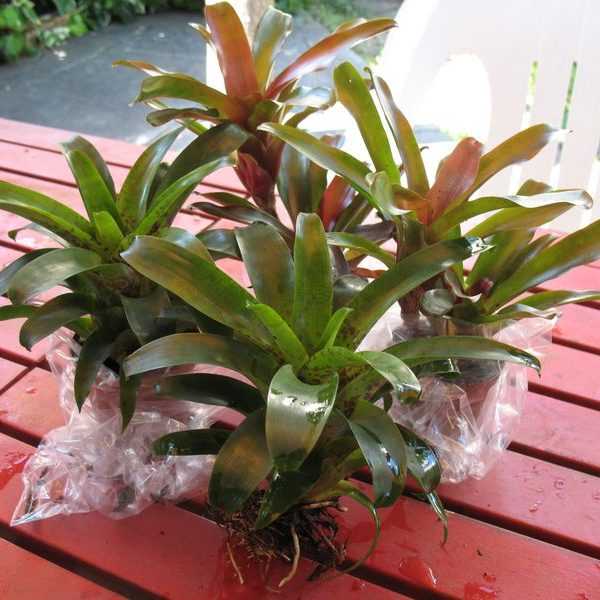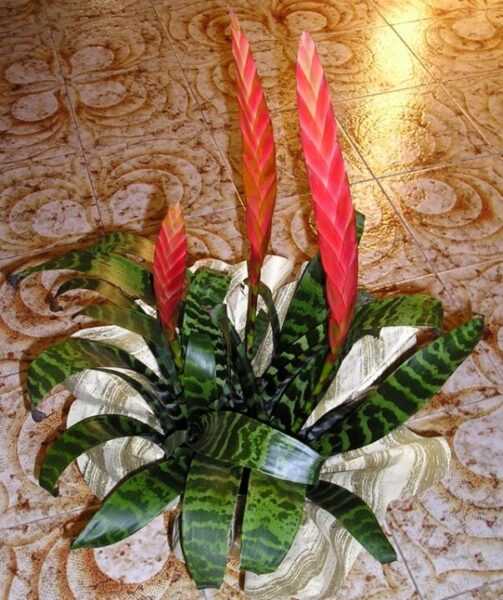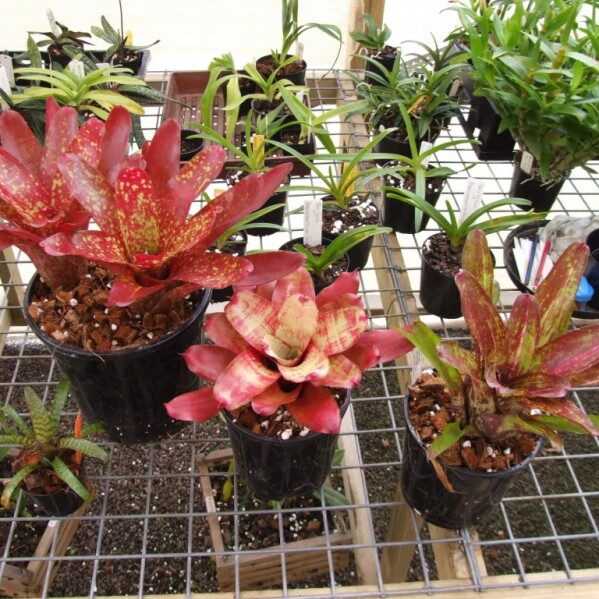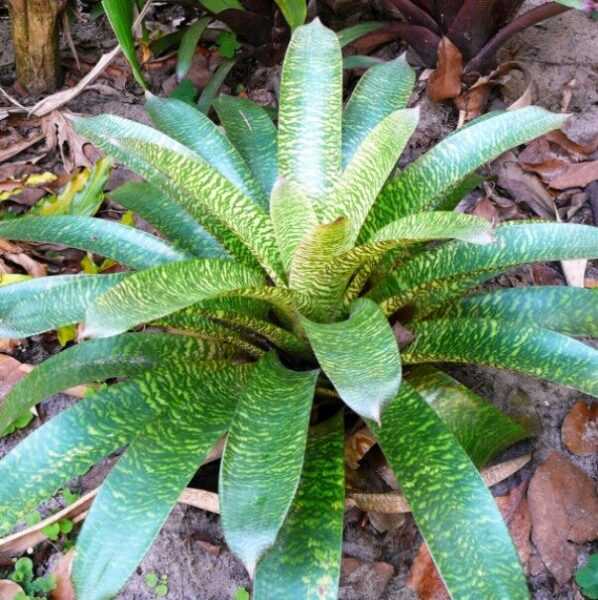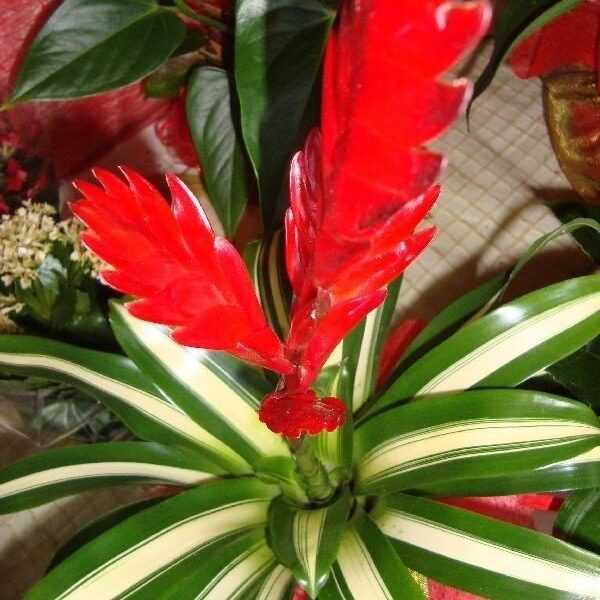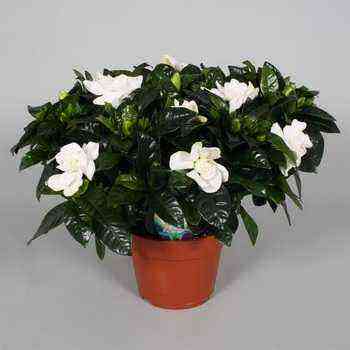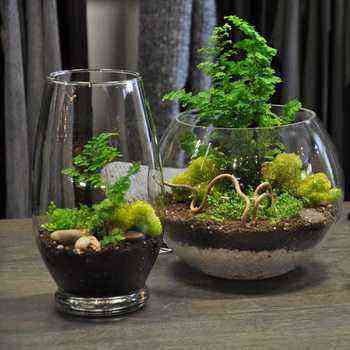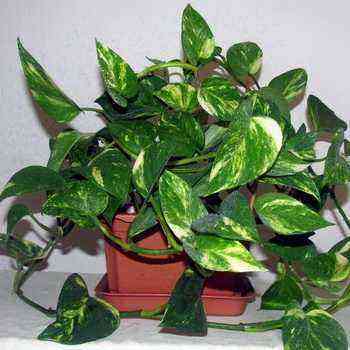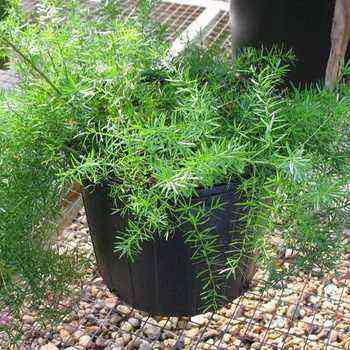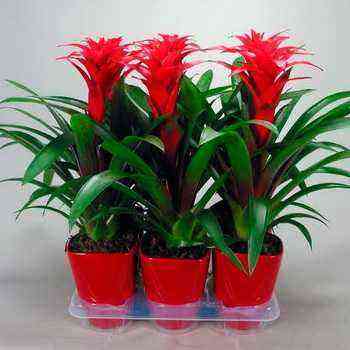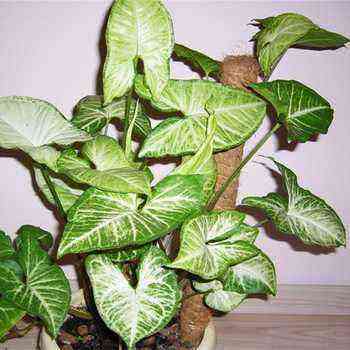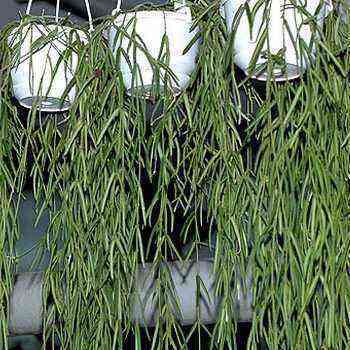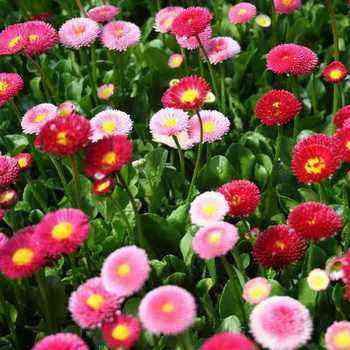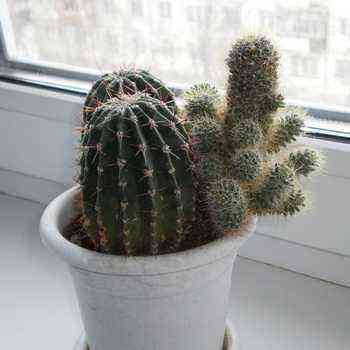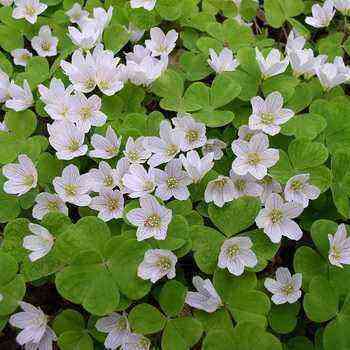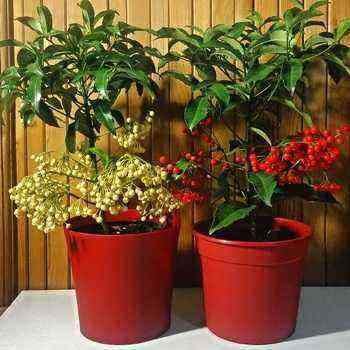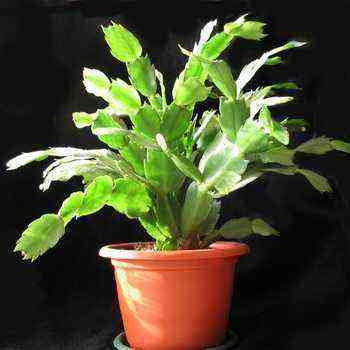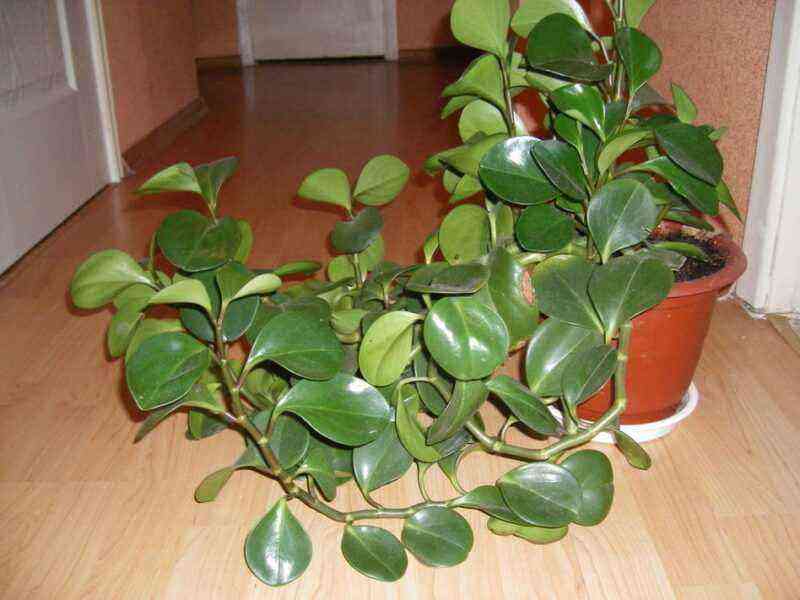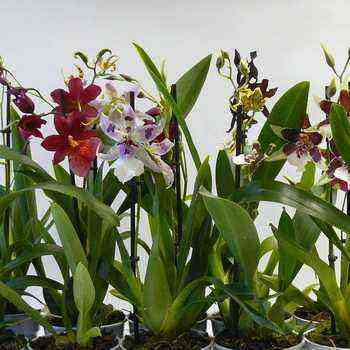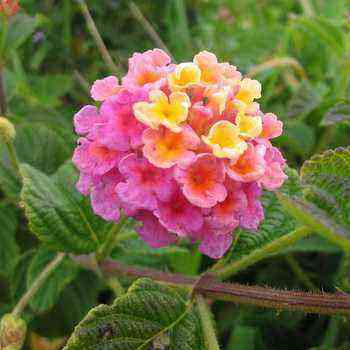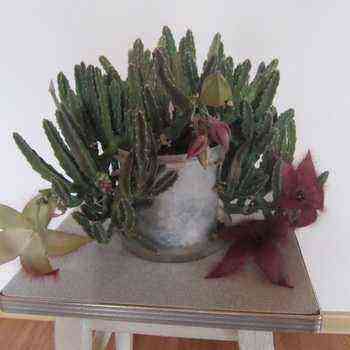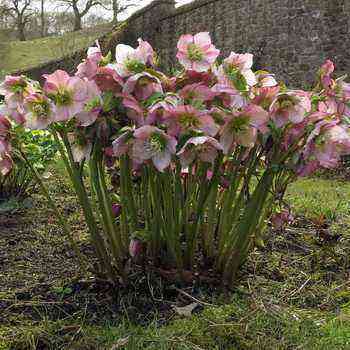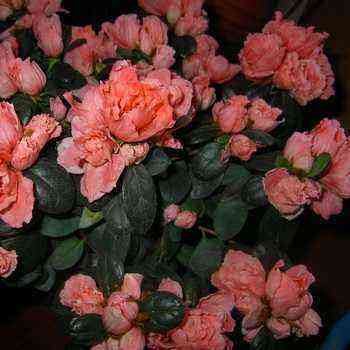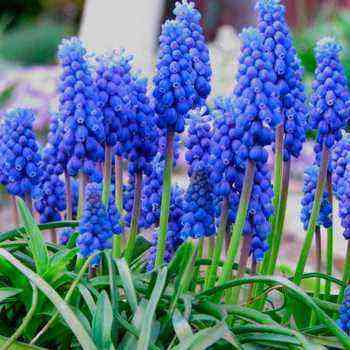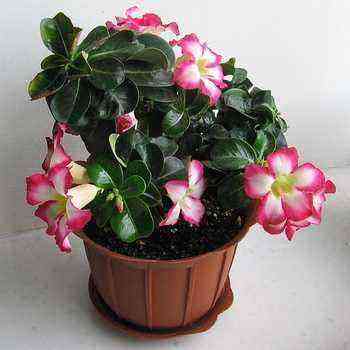Indoor flowers Vriezia are one of the species of the genus of the botanical family Bromelivaceae, subfamily Tilansiodaceae. The genus got its name from Willem Hendrik de Vriez, a Dutch botanist and doctor. The second name is the Flaming (brilliant) sword. All 250 known species are native to Central and South America, and there are also a large number of hybrids. Thus, vriezia is divided into flowers, which are grown mainly for foliage and those that are valued for the fruit with bright flower thorns. We offer you a description of Vriezia and its photos, which show numerous varieties and species.
Almost any species can adapt to being at home, although flowering species do best outdoors. These varieties are very closely related to Tilandsia, which is especially noticeable in the structure of the flower.
It contains one of the largest bromeliads species and these tropical flowers harbor a wide variety of insects in the fauna, in contrast to the smaller species. This genus is very closely related to Guzmania. What they have in common is the presence of dry capsules, which, when broken, release a parachute from the seeds, similar to a dandelion. The most resistant varieties grow on trees without roots.
Description of the indoor plant Vriezia and its photo
By the way, the vriezia flower has no roots, instead there are special retaining sprouts that do not accept any nutrients. All nutrients are taken in the center through the center with a rosette of leaves. Most often, Vriezia grows on rocks or tree trunks in its native environment.
As in other varieties of bromeliads, the process of budding in a houseplant Vriezia takes about 3-4 years. But this phenomenon is worth the wait, because in addition to colorful foliage, Vriezia flowers produce flowers with exceptional thorns – in the shape of a sword. Their color can vary from white to yellow and even green.
Another interesting feature of Vriezia, judging by the opsyania, are the seeds that look like dandelion in appearance. They usually produce seeds – capsules that dry and open the seeds (they are very similar to those found in dandelions). True, propagation is most often achieved by separation or displacement from the mother plant. Look at the photo:
Most Vrieseia houseplants are epiphytic and have a definite vase (flowering) and green belt-shaped leaves. Different species are very different in size – so they can be either five centimeters or one and a half meters.
In some species, leathery leaves ranging in length from 20 to 80 centimeters alternate with thinner ones. The blunt end of the foliage has a dark, green-violet surface that resembles common spots. The rigid stem of the flower rises above the center of the bush and has purple-green branches and greenish-white flowers. Vriese bracts last for a very long time, while the flowers wither in just a couple of weeks. Soon after the bracts die out, the parent plant – in order for the cycle of growth and development to occur further, it is necessary to collect shoots from the trunk for the future bush. But it is worth knowing that, unlike other Bromeliads, the process of growth and development in a Vriese flower takes from two to four years. The process can be accelerated by placing the sprout in a greenhouse or in a plastic bag with cut apples, which, thanks to the substances contained, contribute to the more active growth of the flower.
How to care for vriezia at home
To begin with, before caring for Vrieseia at home, you should remember that the flowering time is directly related to the time of planting.
Vriezia in indoor conditions has very sensitive roots, so you should pay special attention to the conditions of care, especially temperature and humidity.
Vriesia flowers need bright light in partial shade, as the leaf will be brighter and larger if it receives a sufficient portion of the sun. But if you grow Vriezia with bright foliage at home, then you need to protect it from direct sunlight – there is a very high probability that the leaves will simply burn out.
The plant does not tolerate temperature changes, therefore, when growing indoor vriezia, it is necessary to take care of the air temperature in the room – it is not less than 20 degrees Celsius, and for the soil – at least 18. This should be taken into account when organizing care for vriezia at home
Water should not stagnate in the bush, by the way, it must be watered precisely through the funnels of the foliage. When the temperature begins to drop below 20 degrees, you should immediately remove all excess moisture on the plant. If soil gets into the funnels, the flower can die. It is impossible to overmoisten the soil, but it is necessary to water it regularly. If Vriezia is transferred to a greenhouse in winter, then watering should also remain regular, but if it remains in a cool place, it should be watered very carefully, and moreover, less often than usual.
Water for irrigation should be warm (above room temperature) and soft – settled rain and bottled water are perfect for this.
Air humidity when caring for vriezia at home should be at least 50%. Maintain the level of humidity, and, if necessary, increase, possibly by spraying twice a day (but not on the bracts). You can also line the roots with damp pebbles or moss, which need to be re-moistened from time to time. One important condition is that the water and the bottom of the pot should not touch each other in any way.
The ideal conditions for the growth, development and care of Vrieseia at home is the terrarium. Take a look at the photo of Vriezia in the terrarium and appreciate the beauty of the resulting plants.
Vrieseia transplant and aftercare
The transplant begins at the moment when processes appear at the base of the vriezia. When they reach several months, they can already be removed from the mother tree and transplanted into a separate compost of sod and leafy soil, peat, pine bark, moss and sand. Fertilizer should be used very rarely (about twice a week) and very carefully, placing it only in the center of the pot. Necessarily – a low nitrogen content and the absence of calcium in it. After planting in a ready-made substrate, the flower must be covered with glass or polyethylene and given time. When Vriezia significantly increases in growth, you can immediately transplant it into a separate, deeper and wider pot.
You should know that indoor vriezia flowers do not like transplants very much, therefore, if necessary, carry out this procedure as rarely as possible. And take care of the roots – any oversight can lead to long-term vriezia disease.
Reproduction of indoor flowers vriezia
Indoor vriezia flowers reproduce by shoots and seeds. We have already described the first method above.
Flower seeds must be sown in the soil with peat and the first shoots will appear in about two weeks. True, it is still a very, very long time before the flowers appear – you will have to wait at least three to four years before the vriezia blooms. You can grow Vrieseia in separate pots 20-40 centimeters in diameter, or in driftwood
Vriezia mix
Vriezia mix is a species of the Bromeliad family native to South and Central America. Outwardly, it very much resembles a finished bouquet thanks to its shiny foliage and bright feather with bracts of the brightest colors – from yellow to red. They retain their beautiful appearance for a very long time.
The conditions for caring for Vriesia mix are the same as for the main species – Vriesia.
Vriezia splenriet or Vriezia brilliant
Vriezia splenriet is also called a fiery sword. It is a genus of flowering plants in the bromeliad family. Her homeland is Guinea and Venezuela. This variety was introduced to Europe in 1840. The flower has smooth leaves with brown stripes, grows in rosettes. The shrub usually produces bright red, flat-flowered inflorescences.
